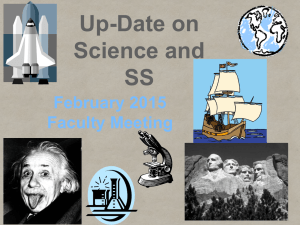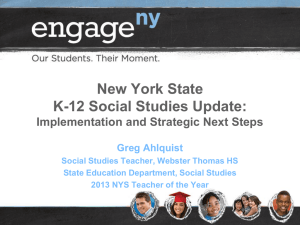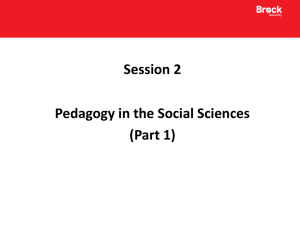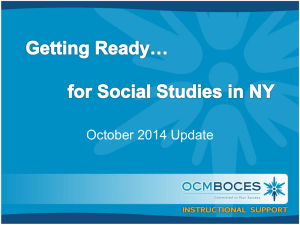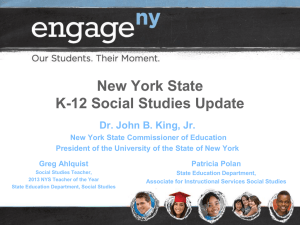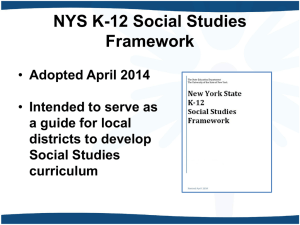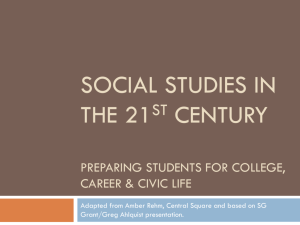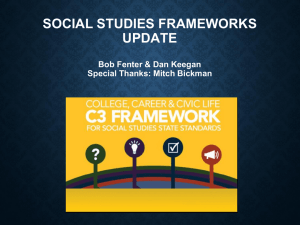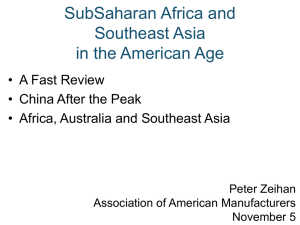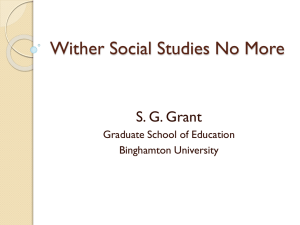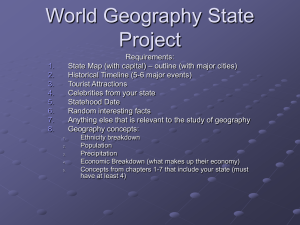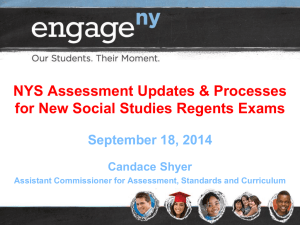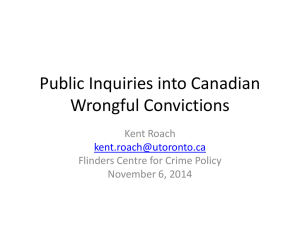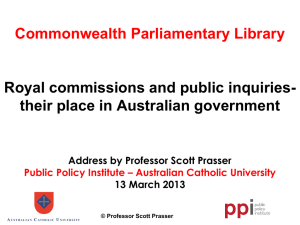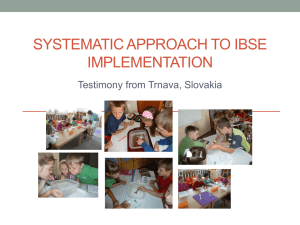Presentation
advertisement
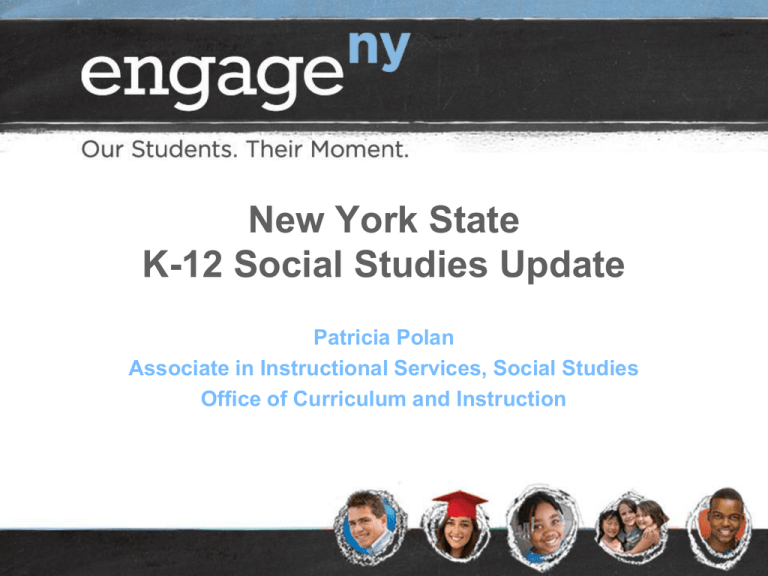
New York State K-12 Social Studies Update Patricia Polan Associate in Instructional Services, Social Studies Office of Curriculum and Instruction Louis E. Yavner Awards The Board of Regents invites nominations for the Louis E. Yavner Teaching and Citizen Awards. These awards provide recognition of a teacher and a citizen who have made outstanding contributions to New York State education about the Holocaust and other violations of human rights. The awards were established by the Regents and funded by the late Regent Emeritus Louis E. Yavner. See: http://www.p12.nysed.gov/ciai/Yavner/ Deadline: December 15, 2014 2 Board of Regents Adopted the New York State K-12 Social Studies Framework in April 2014 Informed of regulation change for Social Studies at September 2014 meeting Presented with regulation change language at the October 2014 meeting Regulation Language to be posted on the State Register http://www.dos.ny.gov/info/register/2014.html 3 Proposed Regulation Change Social Studies: • 2 units of credit Global History and Geography • 10th grade Regents exam (only 10th grade content) • June 2018 will be first administration of new exam 4 Test Development Timeline • Spring 2015 – Training of item writers • Spring 2016 – Piloting of new items • Spring 2017 – Full-scale field testing of items • June 2018 – Global History & Geography II first administration • June 2019 – US History & Government first administration 5 New York State K-12 Social Studies Framework Same 5 NYS Social Studies Learning Standards • Standard 1: History of the United States and New York • Standard 2: World History • Standard 3: Geography • Standard 4: Economics • Standard 5: Civics, Citizenship, and Government Course of Study Remains Same Grade Course of Study Kindergarten Grade 1 Grade 2 Grade 3 Grade 4 Grade 5 Grade 6 Grade 7 Grade 8 Grade 9 Grade 10 Grade 11 Self and Others Grade 12 My Family and Other Families, Now and Long Ago My Community and Other Communities Communities around the World Local History and Local Government The Western Hemisphere The Eastern Hemisphere United States and New York History – I United States and New York History – II Global History and Geography – I Global History and Geography – II United States History and Government Participation in Government Economics and Economic Decision Making The Foundation: Key Ideas, Conceptual Understandings & Content Specifications KEY IDEAS CONCEPTUAL UNDERSTANDINGS CONTENT SPECIFICATIONS Social Studies Practices 1. Gathering, Using, and Interpreting Evidence 2. Chronological Reasoning and Causation 3. Comparison and Contextualization 4. Geographic Reasoning 5. Economics and Economics Systems 6. Civic Participation Common Core Literacy Skills • Reading Key Ideas and Details Craft and Structure Integration of Knowledge & Ideas Range of Reading & Text Complexity • Writing Text Types and Purposes Production and Distribution of Writing Research to Build and Present Knowledge Range of Writing • Speaking and Listening Comprehension and Collaboration Presentation of Knowledge and Ideas Unifying Themes 1. 2. 3. 4. 5. 6. 7. 8. 9. 10. Individual Development & Cultural Identity Development, Movement & Interaction of Cultures Time, Continuity & Change Geography, Humans and the Environment Development and Transformation of Social Structures Power, Authority & Governance Civic Ideals Creation, Expansion and Interaction of Economic Systems Science, Technology and Innovation Global Connections and Exchange 12 How to Read the Framework Key Idea Conceptual Understanding 4.5 IN SEARCH OF FREEDOM AND A CALL FOR CHANGE: Different groups of people did not have equal rights and freedoms. People worked to bring about change. The struggle for rights and freedoms was one factor in the division of the United States that resulted in the Civil War. (Standards: 1, 5; Themes: ID, TCC, SOC, CIV) 4.5a There were slaves in New York State. People worked to fight against slavery and for change. Content Specifications Students will examine life as a slave in New York State. Students will investigate people who took action to abolish slavery, including Samuel Cornish, Fredrick Douglass, William Lloyd Garrison, and Harriet Tubman. NY Social Studies Framework 3 Instructional Shifts • Focus on Conceptual Understanding. • Foster Student Inquiry, Collaboration, and Informed Action. • Integrate Content and Skills Purposefully. Instructional Shift #1: Focus on Conceptual Understanding From To Facts Concepts and Content???? Knowledge Breadth of Topics Depth within ???? Topics Recall Transfer and ???? Connections Instructional Shift #2: Foster Student Inquiry, Collaboration, and Informed Action From To Teacher as Disseminator Teacher as Facilitator ???? of Investigation Students Learn Facts from Textbook Students Investigate the Social Sciences ???? Using Multiple Sources Students Retell Interpretations Students Construct Interpretations ???? and Communicate Conclusions Instructional Shift #3: Integrate Content and Skills Purposefully FROM A Social Studies Classroom Where… TO A Social Studies Classroom Where… Students experience an additional nonfiction reading class or textbook focused instruction Students learn to read, discuss, and write like???? social scientists Students develop literacy skills and social studies practices separately Students develop disciplinary literacy skills ???? and social science practices in tandem Students learn content knowledge Students integrate and apply ???? and content concepts, skills, knowledge C3 Inquiry Arc What is the C3 Framework? Inquiry Arc • Dimension 1: Developing Questions and Planning Inquiries • Dimension 2: Applying Disciplinary Tools and Concepts (Civics, Economics, Geography, and History) • Dimension 3: Evaluating Sources and Using Evidence • Dimension 4: Communicating Conclusions and Taking Informed Action NYS K-12 Social Studies Resource Toolkit Project • To marry the global vision of the C3 Framework to the content specifics of the NYS Framework in a way that honors, supports, and extends teachers’ and students’ best classroom ambitions • Partnership with SUNY Binghamton; collaboration with C3 authors • Develop Toolkit to equip teachers and districts to design curriculum and instruction The toolkit project What…and When •Resources —14 Annotated Inquiries (1 per grade) and 70 Abridged Inquiries/(5 per grade) July 2014-August, 2015 •Professional Development—District, State-Level, and National/July 2014-August 2015 •Assessment—Assistance with design of new Regents exams/Spring 2015-Spring 2018/19 A new paradigm for social studies • In content-rich subjects, traditionally it has been facts first, thinking later …and it hasn’t worked. * * * * * • The C3 Inquiry Arc starts with thinking with a purpose …answering a compelling question Compelling questions • Intellectually meaty • Kid friendly Intellectually meaty • Reflects an enduring issue, concern, or debate in the field • Demands the use of multiple disciplinary lenses and perspectives Kid friendly • Reflects a quality or condition that we know children care about • Honors and respects children’s intellectual efforts Did Reconstruction Really Free African Americans? •Intellectually meaty? •Kid friendly? Compelling…or not so compelling? 1 Why do we need rules? 2 What are the five largest sources of oil for U.S. markets? 3 Why is Albany the capital of New York? 4 Who are our community helpers? 5 Can Canada and the US be friends forever? 6 Who won the Cold War? Why inquiries rather than units… • Inquiries are not fully-developed content units or modules • An inquiry need not necessarily cover an entire key idea • A Key Idea (e.g., Native Americans in New York) may necessitate several inquiries • Teacher expertise and agency is key What should teachers do NOW? • Review Introduction & Social Studies Practices for Grade Level • Evaluate current instructional practices • Professional Development Readings • Professional Organizations: National, State & Local Councils for the Social Studies New York Geographic Alliance • http://www.nygeographicalliance.org/ New York Elementary Classroom Teachers Association • http://www.nysecta.org/ 30 A Program that Supports Teaching, Learning and Assessment
